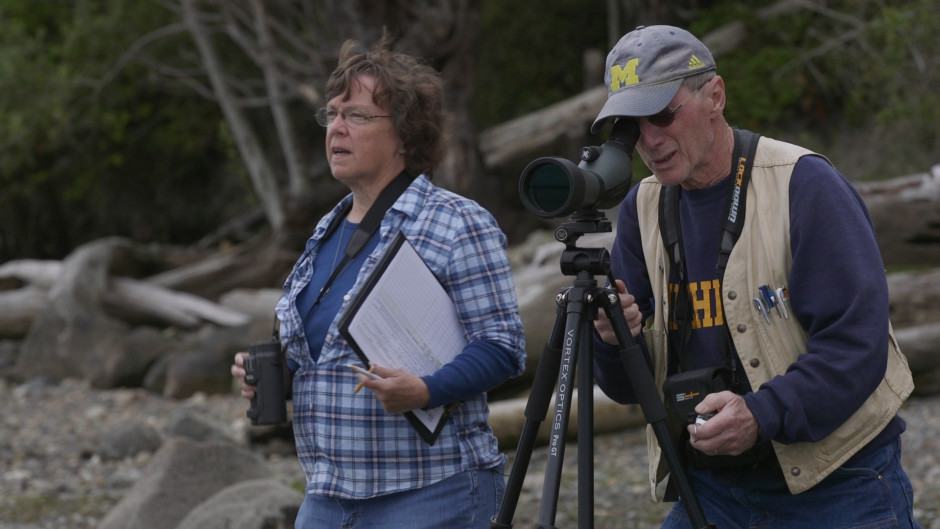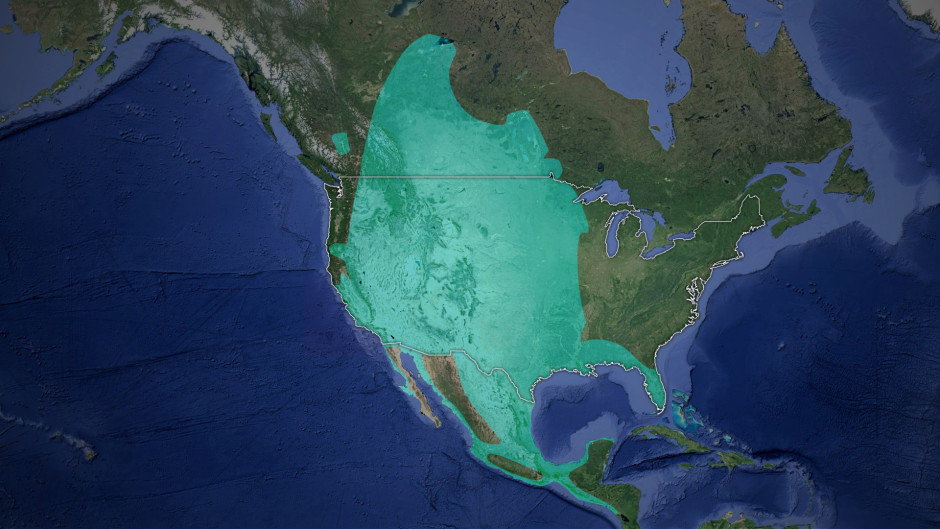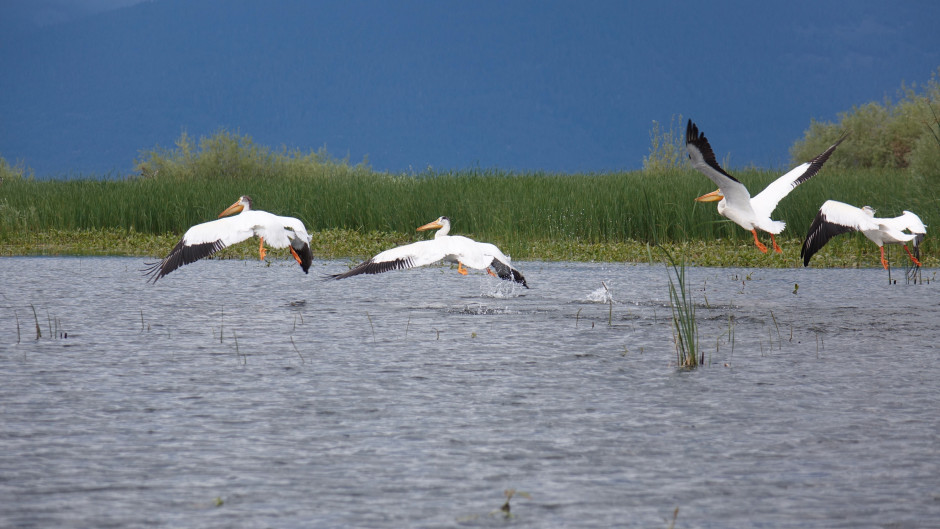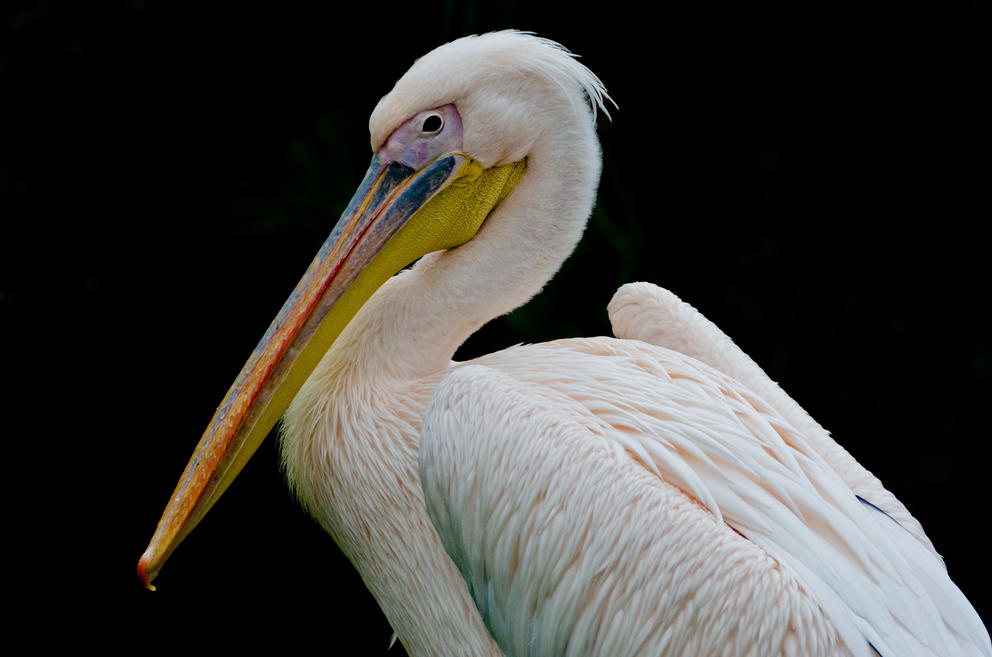This story originally appeared on OPB/EarthFix.
American white pelicans are conspicuous birds. With their long orange bills and their nine-foot wingspan, they stand out, even at a distance.
Sue Ehler easily spots a squadron of them through her binoculars from over a mile away, coming in for a landing on Puget Sound’s Padilla Bay.
“They’ve got that pure white. It just shines like a bright light out there. More than the other white birds,” Ehler says.
Ehler visits this estuary in Northwest Washington every other week from spring to fall with her friend and fellow citizen scientist and retired biologist Matt Kerschbaum. They’re volunteers with the Skagit Heron Foraging Study, tracking the health of the largest breeding colony of great blue herons in the Pacific Northwest.
Ehler and Kerschbaum were among the first to notice the pelicans.
“It was like seeing aliens arrive,” says Ehler, a seasonal biologist with a degree in ornithology. “It’s unprecedented for them to be here, so something really unusual is happening.”
White pelicans are different from brown pelicans, a more common summer visitor to coastal Washington. The white pelicans’ range stretches across much of the country but not into Western Washington.
White Pelicans weren’t a rarity in Washington a century ago, when they were common visitors to the state’s inland waters. But their numbers fell due largely to habitat loss and pesticide use. In recent decades, populations have recovered to the point that the Washington Department of Fish and Wildlife is now recommending that they be uplisted from endangered to threatened.
At first Elher and Kerschbaum counted about a dozen white pelicans in Padilla Bay. But the ranks soon expanded.
“We had a baseline of nothing and suddenly we got a 130. So it kind of sets off the alarms that say, ‘Maybe I should look into this a little bit,’” said Kerschbaum, a retired wildlife refuge manager with U.S. Fish and Wildlife.

They put out a call for sightings with area birding groups and Audubon societies and soon had more than 100 reports — not just in Puget Sound, but also on the Olympic Peninsula and north into coastal British Columbia.
“I wouldn’t be surprised if they aren’t prospecting for new locations,” says Dan Roby, a professor of wildlife ecology at Oregon State University who studies pelicans and other birds. “White pelicans do seem to be expanding and establishing new sites. It seems like it’s only a matter of time.”
Roby says the pressures of climate change could be at play.
Climate Change Refugees
Normally the region’s white pelicans spend the summer near breeding areas farther south and east, raising their young on islands in freshwater lakes and rivers. The surrounding water creates a natural barrier that protects the nestlings from predators. But with parts of Oregon and California are enduring another year of severe drought, prime breeding grounds like Malheur National Wildlife Refuge in Eastern Oregon have been hit hard.
Sections of Malheur Lake have gone dry, creating land bridges that allow coyotes to reach the islands, where young roosting birds are easy prey.

Roby and his team monitor pelican colonies and count breeding pairs. They often fly over known pelican colonies and take aerial photos to avoid disturbing them by approaching by boat or on land. Earlier this summer they flew over Malheur Lake and found only a few hundred birds when normally there would be thousands.
The officials at Malheur reported the pelicans have failed in their breeding efforts there for the past two years.
“After several years of drought, the lake is so low it’ll take two or three good snowpack years to bring the lake back to levels that would support a pelican colony,” Roby said.
So he said the pelicans visiting Puget Sound could be climate change refugees moving north in search of islands surrounded by water that would make a suitable site for a new colony.

Over the last 50 years the median location of pelican colonies across the country has shifted north by almost 200 miles, according to a recent Idaho Fish and Game report.
“For a good disperser like white pelicans that’s not that far,” Roby says. “It’s certainly notable that the median site has moved that far north, but I’m not really surprised. That’s the trend that you see a lot in birds.”
When it comes to climate change, pelicans may be better off than landlocked species. But Roby said he thought the ideal pelican habitat would be difficult to locate in Western Washington.
“It’s hard to find islands in Puget Sound that don’t have human disturbance,” Roby said. “White pelicans are extremely sensitive to human disturbance and will abandon a colony quickly if people get too close.”
And if they did find a suitable location, Roby said their human neighbors may not be so welcoming. That’s because people often assume that pelicans eat young salmon, but actually biologists have found that white pelicans eat small, mostly non-game fish as well as amphibians and crayfish.
Pelicans Out Prospecting
In early July, after a couple months of testing out Padilla Bay, Ehler said, the group of more than one hundred pelicans took off.
“It was just overnight. One day they were here and the next, they were gone,” Ehler said.
Soon she got reports of a large group of pelicans at Deer Lagoon, a quiet inlet on the south end of Whidbey Island that has both a freshwater marsh and a saltwater marsh.

“It’s quite an exciting event. The local residents are all watching them, coming out and checking on them,” said Joe Sheldon, of the Whidbey Audubon Society.
Through a spotting scope, he counted nearly 200 pelicans. He looked closely at their legs, but could see no evidence of tags that could provide clues to where they came from. Over the course of a few hours, he watched as the pelicans swam around the marsh among great blue herons, ducks, terns and geese.
“Species with a variety of ecological requirements find this to be a delightful home and a delightful place to visit,” Sheldon said.
It’s too soon to say if these pelicans are just Puget Sound tourists, or new summer residents.
“Will they come back?” Sheldon asked. “We’ll wait and see for next year.”
To see the pelicans before they migrate south for the winter, here’s how to visit Deer Lagoon. Explore a map of white pelican sightings and submit your own reports at eBird.



